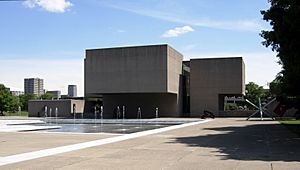Everson Museum of Art facts for kids
 |
|

Museum building, designed by I. M. Pei
|
|
| Established | 1897 |
|---|---|
| Location | 401 Harrison Street, Syracuse, New York, USA |
| Type | Art museum |
| Collections | Ceramic art American Painting Sculpture Video art |
| Founder | George Fisk Comfort |
The Everson Museum of Art (/ˈiːvərsən/ EE-vər-sən) in Downtown Syracuse, New York, is a major Central New York museum focusing on American art.
History
The museum was founded in 1897 by art historian George Fisk Comfort (who also helped found the Metropolitan Museum of Art); at that time, it was called the Syracuse Museum of Fine Arts. On the evening of 22 January 1897, the inaugural meeting was held in the May Memorial Church in Syracuse. In 1911, it announced that it would seek to collect only American art.
Over time the museum occupied several different buildings, including the Onondaga Savings Bank and the Syracuse Public Library, but it outgrew each facility.
In 1932, the Syracuse Museum of Fine Arts initiated their Ceramic National exhibitions, which became the most prestigious juried exhibition in the field of ceramics in the forty years that followed.
In 1941, Helen Everson made a gift of $1 million to the city of Syracuse for the purpose of erecting an art museum. A groundbreaking took place in 1965, and in 1968 the new Everson Museum of Art opened. The new building was designed by architect I. M. Pei and is regarded as a work of art in its own right.
The Everson Museum collaborates with Light Work and the Urban Video Project (UVP) to exhibit video art on the facade of the building, including important works by Bill Viola, Jenny Holzer, William Wegman, among others. In the summer, they host a film series which is very popular for residents of Syracuse.
Collection
The Everson houses roughly 11,000 pieces of art, including paintings, sculpture, ceramics, and video.
The Everson Museum of Art contains one of the most notable collections of ceramic art in the United States. In 1916, The Syracuse Museum of Fine Arts acquired a group of thirty-two works by renowned Syracuse-based potter Adelaide Alsop Robineau. After Robineau's death in 1929, the museum acquired a second group of her porcelains, including the famed Scarab Vase, whose carving reportedly took more than 1000 hours. The museum now contains more than 100 works by Robineau.
In 1932, Museum director Anna Wetherill Olmsted founded the Ceramic National exhibitions as a tribute to Robineau. Over the next forty years, the Ceramic Nationals became the preeminent juried exhibition for the field of ceramics. Purchase prizes were given to artists each year, which added pieces by such artists as Waylande Gregory, Maija Grotell, Marguerite Wildenhain, Peter Voulkos, Otto and Vivika Heino, Maria Martinez, Gertrud and Otto Natzler, and Robert Turner to the museum's collection.
Paintings include one of Gilbert Stuart's portraits of George Washington, Edward Hicks's The Peaceable Kingdom, and works by Eastman Johnson, Charles Burchfield, Helen Frankenthaler, Jackson Pollock and others as well as outdoors sculptures (Marja Vallila). In 1980 the Everson introduced Ching Ho Cheng's "Intimate Illuminations", the first Chinese-American contemporary painter to exhibit a one-man show nationally.
The Syracuse China Center for the Study of Ceramics is one of the largest ceramics collections in the nation, with pieces ranging from ancient sculpture and Ming dynasty porcelain up to contemporary works.
The museum established one of the first video art collections in the United States; its video collection is the largest in the world. Nam June Paik exhibited early works at the Everson, including his United States retrospective in 1974. Bill Viola's first job was as a video technician at the Everson; his works are now in the collection.
The museum also has a collection of Arts and Crafts Movement furniture, featuring a number of works of Gustav Stickley.
The Building
The Everson Museum of Art is designed to be a sculpture in itself. The design intention that I.M. Pei achieved was for the building to be a grand sculptural object surrounded by the modern architecture of the surrounding buildings of the city. He wanted his museum to stand out compared to the buildings next to it. He didn't want the building to be simply a "monumental container for art," but rather art in it of itself.
Skateboarding
Skateboarders started skating at the Everson Museum of Art in the mid-1980s. The museum is a famous location for skateboarders, considered by some an “East Coast skate mecca." Filmmaker Bill Strobeck grew up outside of Syracuse and often came to Everson to skate with friends in the 1990s. It was in the plaza outside of the museum that Strobeck first started filming his friends skating. At that time, the museum welcomed the skaters to skate the plaza; it has since been made illegal. In 2007, on National Go Skateboarding Day, the museum made an exception, allowing skating at the plaza for the day. As of 2007, Central New York skateboarders have a campaign to re-open the plaza to skateboarding, using the saying "FREE eVe," meaning free the Everson Museum of Art.
Location
The museum is located in the southeast corner of Downtown Syracuse, at 401 Harrison Street, near the Oncenter complex. It is directly accessible from Interstate 81 Exit 18 (Adams Street / Harrison Street).
Notable traveling exhibitions
The Everson has presented a number of exhibitions that are available for loan, either in entirety or broken down as individual artworks, including:
- Good Design: Stories from Herman Miller
- Fantasies and Fairy-Tales: Maxfield Parrish and the Art of the Print
- Turner to Cézanne: Masterpieces from the Davies Collection, National Museum Wales
- Pollock Matters
- Marie Antoinette: Styling the 18th-Century Superstar


